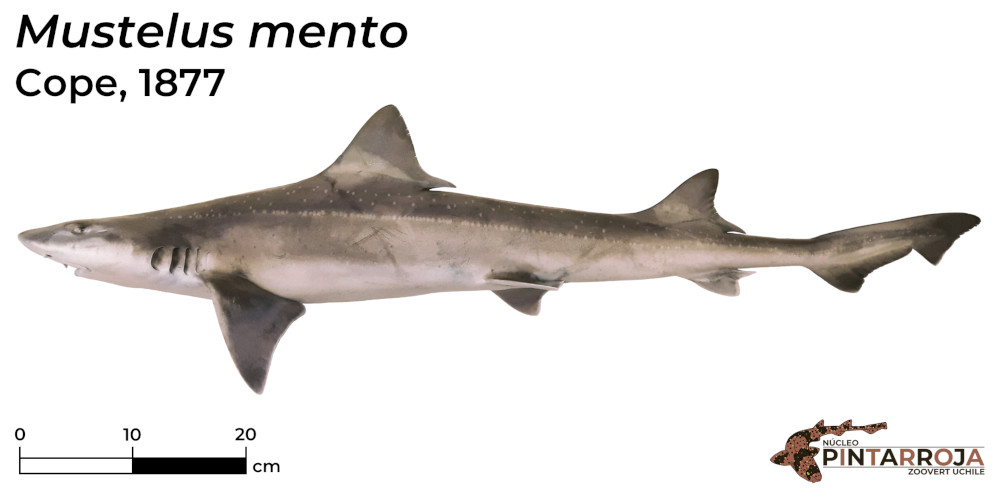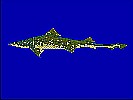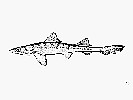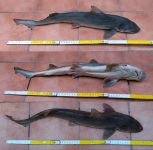Mustelus mento
Cope, 1877
Speckled smooth-hound
Classification: Elasmobranchii Carcharhiniformes Triakidae
Reference of the original description
Synopsis of the cold blooded Vertebrata, procured by Prof. James Orton during his exploration of Peru in 1870-77. Proceedings of the American Philosophical Society, 17, 33–49
Synopsis of the cold blooded Vertebrata, procured by Prof. James Orton during his exploration of Peru in 1870-77. Proceedings of the American Philosophical Society, 17, 33–49
Image of the original description
No image in first description.
No image in first description.
Synonyms / new combinations and misspellings
Galeorhinus mento, Galeus mento, Mustelus abbotti, Mustelus edulis
Galeorhinus mento, Galeus mento, Mustelus abbotti, Mustelus edulis
Types
Mustelus mento
Holotype: ANSP: 21104;
Mustelus abbotti
Holotype: USNM: 77696; Paratype: USNM: 77543;
Mustelus edulis
Syntype: MHNV: ?
Mustelus mento
Holotype: ANSP: 21104;
Mustelus abbotti
Holotype: USNM: 77696; Paratype: USNM: 77543;
Mustelus edulis
Syntype: MHNV: ?
Description :
Citation: Mustelus mento Cope, 1877: In: Database of modern sharks, rays and chimaeras, www.shark-references.com, World Wide Web electronic publication, Version 01/2026
Please send your images of "Mustelus mento" to info@shark-references.com

Mustelus mento Cope, 1877, Chile © L. Ignacio Contreras, Laboratorio de Zoología de Vertebrados, Facultad de Ciencias, U. de Chile

Mustelus mento Cope, 1877, Chile © L. Ignacio Contreras, Laboratorio de Zoología de Vertebrados, Facultad de Ciencias, U. de Chile
Common names
 Musola fina,
Musola fina,  Piruche,
Piruche,  Tollo,
Tollo,  Tollo blanco,
Tollo blanco,  Tollo con bandas,
Tollo con bandas,  Tollo fino,
Tollo fino,  Emissole fine,
Emissole fine,  Smooth hound,
Smooth hound,  Speckled smooth hound,
Speckled smooth hound,  Speckled smooth-hound,
Speckled smooth-hound,  Tollo con fajas
Tollo con fajas
 Musola fina,
Musola fina,  Piruche,
Piruche,  Tollo,
Tollo,  Tollo blanco,
Tollo blanco,  Tollo con bandas,
Tollo con bandas,  Tollo fino,
Tollo fino,  Emissole fine,
Emissole fine,  Smooth hound,
Smooth hound,  Speckled smooth hound,
Speckled smooth hound,  Speckled smooth-hound,
Speckled smooth-hound,  Tollo con fajas
Tollo con fajas
Short Description
Diagnosis after Compagno, 1984 [517]: Body fairly slender. Head short, prepectoral length 17 to 21% of total length; snout moderately long and bluntly angular in lateral view, preoral snout 5.7 to 7.4% of total length, preorbital snout 5.8 to 7.8% of total length; internarial space very narrow, 1.8 to 2.4% of total length; eyes fairly large, eye length 2 to 3.1 times in preorbital snout and 2.1 to 3.5% of total length; interorbital space fairly narrow, 4.3 to 5.3% of total length; mouth short, subequal to eye length and 2.3 to 3.2% of total length; upper labial furrows considerably longer than lowers and 1.8 to 2.6% of total length; teeth molariform and asymmetric, with cusps low and rounded; buccopharyngeal denticles not known. Interdorsal space 17 to 23% of total length; trailing edges of dorsal fins naked, with a band of bare ceratotrichia; first dorsal broadly triangular, with posteroventrally sloping posterior margin, its midbase closer to pelvic bases than to pectorals; pectoral fins fairly small, length of anterior margins 12 to 16% of total length, width of posterior margin 8.6 to 13% of total length; pelvic fins small, anterior margin length 6.7 to 8.7% of total length; anal height 2.5 to 3.5% of total length; anal caudal space slightly greater or subequal to second dorsal height, and 5.8 to 7.8% of total length; ventral caudal lobe not expanded and falcate in adults. Crowns of lateral trunk denticles lanceolate, with longitudinal ridges extending at least half their length. Cranium, hyomandibulae, scapulocoracoids not hypercalcified in adults; palatoquadrates not subdivided; monospondylous precaudal centra 36 to 39, diplospondylous precaudal centra 45 to 54, precaudal centra 82 to 88. Colour grey above, light below, often with numerous white spots but no dark spots or dark bars. Development ovoviviparous. Size moderate, adults 48 to 74 cm.
Diagnosis after Compagno, 1984 [517]: Body fairly slender. Head short, prepectoral length 17 to 21% of total length; snout moderately long and bluntly angular in lateral view, preoral snout 5.7 to 7.4% of total length, preorbital snout 5.8 to 7.8% of total length; internarial space very narrow, 1.8 to 2.4% of total length; eyes fairly large, eye length 2 to 3.1 times in preorbital snout and 2.1 to 3.5% of total length; interorbital space fairly narrow, 4.3 to 5.3% of total length; mouth short, subequal to eye length and 2.3 to 3.2% of total length; upper labial furrows considerably longer than lowers and 1.8 to 2.6% of total length; teeth molariform and asymmetric, with cusps low and rounded; buccopharyngeal denticles not known. Interdorsal space 17 to 23% of total length; trailing edges of dorsal fins naked, with a band of bare ceratotrichia; first dorsal broadly triangular, with posteroventrally sloping posterior margin, its midbase closer to pelvic bases than to pectorals; pectoral fins fairly small, length of anterior margins 12 to 16% of total length, width of posterior margin 8.6 to 13% of total length; pelvic fins small, anterior margin length 6.7 to 8.7% of total length; anal height 2.5 to 3.5% of total length; anal caudal space slightly greater or subequal to second dorsal height, and 5.8 to 7.8% of total length; ventral caudal lobe not expanded and falcate in adults. Crowns of lateral trunk denticles lanceolate, with longitudinal ridges extending at least half their length. Cranium, hyomandibulae, scapulocoracoids not hypercalcified in adults; palatoquadrates not subdivided; monospondylous precaudal centra 36 to 39, diplospondylous precaudal centra 45 to 54, precaudal centra 82 to 88. Colour grey above, light below, often with numerous white spots but no dark spots or dark bars. Development ovoviviparous. Size moderate, adults 48 to 74 cm.
Distribution
Eastern Pacific: Peru to southern Chile, including the Galapagos and Juan Fernández Islands. Source: www.gbif.org
Eastern Pacific: Peru to southern Chile, including the Galapagos and Juan Fernández Islands. Source: www.gbif.org
Human uses
fisheries: highly commercial; price category: medium; price reliability: questionable: based on ex-vessel price for species in this genus
fisheries: highly commercial; price category: medium; price reliability: questionable: based on ex-vessel price for species in this genus
Remarks
shark-references Species-ID=3807;
shark-references Species-ID=3807;
Parasites (arranged by Jürgen Pollerspöck)
Monogenea
Cestoda
Monogenea
- Microbothrium tolloi Brinkmann, 1952 [22565]
Cestoda
- Calliobothrium sp. [25154]
- Calliobothrium verticillatum (Rudolphi, 1819) [16182] [25154]
- Dollfusiella musteli (Carvajal, 1974) [16182] [16112] [25154]
- Orygmatobothrium musteli (Van Beneden, 1850) [16182] [16923] [16930] [25154]
- Orygmatobothrium sp. [25154]
- Phyllobothrium lactuca Van Beneden, 1850 [16182] [25154]
- Phyllobothrium sp. [25154]
- Scyphophyllidium triacis (Yamaguti, 1952) [16182] [25154]
- Scyphophyllidium uruguayense Brooks, Marques, Perroni & Sidagis, 1999 [7614] [25154]



















